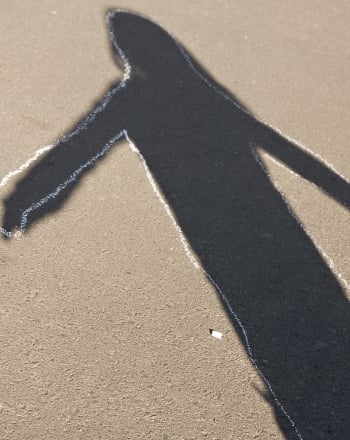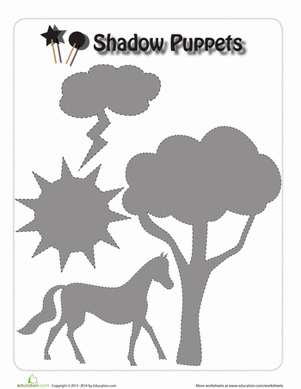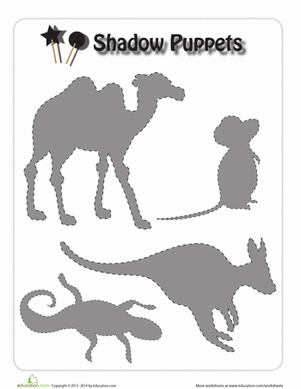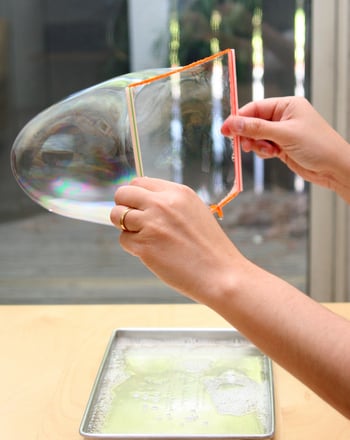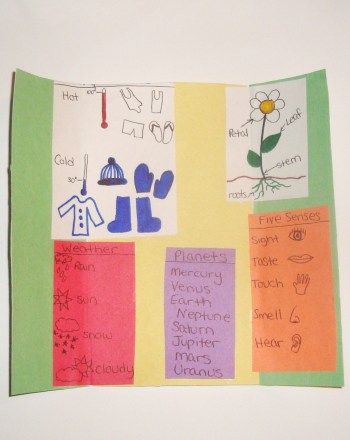Science project
Shadow Science: What Makes Shade Shift?
Shadows are sneaky things: they run ahead of you, jump behind you, and sometimes even disappear completely! Even Peter Pan had trouble catching his shadow.
Believe it or not, all that sneakiness is actually the result of shadow science. Your shadow changes size and shape during the day and then runs and hides when it gets dark—unless you're near a light. So, what exactly makes your shadowy twin dance around all day? Let's play detective and find out why that sneaky shadow never stays in one place for long.
Problem:
What makes shadows change size and shape throughout the day?
Materials:
- Moonbear's Shadow by Frank Asch
- Large tarp
- Chalk
- Notebook
- Pencil
- Friend
Procedure:
- Read Moonbear's Shadow with an adult. Look closely at the pictures and talk about what you see.
- Think about your own shadow. Have you ever seen your shadow act like Moonbear's shadow? What makes our shadows dance around in such a funny way? Write down any of your thoughts down in your notebook.
- Make a guess about what makes your shadow change size and shape throughout the day. Write your guess—called a hypothesis—in your shadow science notebook.
- Place a large tarp on the ground. For the best results, try to start your project in the morning on a nice sunny day.
- Ask a friend to stand on the tarp and face the sun.
- Use your chalk to trace, or outline, your friend's shoes as he stands on the tarp.
- Next, trace your friend's shadow on the tarp.
- Note the time of day in your notebook.
- Make any observations, or thoughts about what you see, in your notebook. How big is your friend's shadow? Is it stretched out or squashed short?
- Look to see where the sun is. Is the sun high in the sky or low on the horizon, the line where the sky and the land meet. Note these observations in your notebook as well.
- Repeat steps 5-10 every few hours throughout the day. Make sure your friend faces the same direction every time you trace his shadow—just make sure his feet line up with the chalk outline you made before.
- Make your last shadow outline when the sun starts to set.
- Once you're finished, take a look at your tarp. Did the shadows move and change shape the way you were expecting?
Results:
Your shadow will be the biggest and the longest when the sun is near the horizon—right in the morning after the sun rises and right in the afternoon before the sun sets. In the middle of the day, around lunchtime, your shadow will become very small. It might even disappear!
Why?
Think about the sun as it was shining in your backyard. Why was almost everything bright except for your friend's shadow? Well, when we're outside during the daytime, our bodies are actually blocking some of the sun's light. The sun's light can't shine through our bodies—that's why shadows are always very dark.
As the sun moves around in the sky, our shadows move around too. When the sun is near the horizon, our bodies block more light. The more light we block, the bigger the shadow. But when the sun is high above us, the light is only shining down on our heads. Our heads don't take up much room, so our shadows are very small at this time of the day.
Do you think shadows can only be created by light from the sun? Find out! What would happen if you tried to "lose" your shadow like Moonbear? Do you think you could do it? Guessing and testing is a big part of being a scientist. Now that you know more about the relationship light and dark, use your new knowledge to invent more shadow experiments.
Education.com provides the Science Fair Project Ideas for informational purposes only. Education.com does not make any guarantee or representation regarding the Science Fair Project Ideas and is not responsible or liable for any loss or damage, directly or indirectly, caused by your use of such information. By accessing the Science Fair Project Ideas, you waive and renounce any claims against Education.com that arise thereof. In addition, your access to Education.com's website and Science Fair Project Ideas is covered by Education.com's Privacy Policy and site Terms of Use, which include limitations on Education.com's liability.
Warning is hereby given that not all Project Ideas are appropriate for all individuals or in all circumstances. Implementation of any Science Project Idea should be undertaken only in appropriate settings and with appropriate parental or other supervision. Reading and following the safety precautions of all materials used in a project is the sole responsibility of each individual. For further information, consult your state's handbook of Science Safety.

